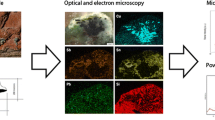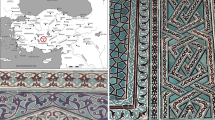Abstract
Twelve fragments of glazed tiles from the fifteenth century tomb of Alauddin Ahmad Shah in Bidar, India, were investigated by scanning electron microscopy with energy-dispersive spectrometry and optical microscopy. Ten of these fragments were of polychrome tiles, and two of monochrome yellow-coloured tiles. All the samples are characterised by the stonepaste type of bodies associated with fritware. The glazes show indigenous features in their chemical compositions, suggesting local production. Microstructural and chemical characteristics indicate that the polychrome tiles were underglaze-decorated and provided with a single transparent alkali glaze. Colorants used include copper, cobalt, and manganese oxides, all of which were applied by painting over a white slip/body. The yellow glazes of the monochrome tiles were coloured by lead–tin yellow. The findings highlight the unusual use of stonepaste underglaze-painted polychrome tiles as a source of architectural decoration in fifteenth century southern India.









Similar content being viewed by others
Data availability
All relevant data generated or analysed for this study are included in this published article (and its supplementary information files).
Code availability
Not applicable.
References
Allan JW (1973) Abu’l Qasim’s treatise on ceramics. Iran 11:111–120
Brill RH (1987) Chemical analyses of some early Indian glasses. In: Bhardwaj, H. C. (ed.) Archaeometry of glass: Proceedings of the archaeometry session of the XIV International Congress on Glass - 1986, New Delhi, India. Part 1. Calcutta, Indian Ceramic Society, pp 1–25
Brill RH (2003) The glassmakers of Firozabad and the glassmakers of Kapadwanj: two pilot video projects. In: Annales du 15e Congrès de l’Association Internationale pour l’Histoire du Verre, Corning, New York, 2001. Nottingham, U.K., AIHV, 2013, pp 267–268
Brown P (1964) Indian architecture (Islamic period). Taraporevala Sons & Co. Private Ltd, Bombay
Buchanan F (1807) A journey from Madras through the countries of Mysore, Canara and Malabar III. T. Cadell & W. Davies, London
Chapoulie R, Delery C, Daniel F, Vendrell-Saz M (2005) Cuerda seca ceramics from al-Andalus, Islamic Spain and Portugal (10th-12th centuries AD): Investigation with SEM-EDX and cathodluminescence. Archaeometry 47(3):519–534
Clark R, Cridland L, Kariuki B, Withnall R (1995) Synthesis, structural characterisation and Raman spectroscopy of the inorganic pigments lead tin yellow types I and II and lead antimony yellow: their identification on medieval paintings and manuscripts. J Chem Soc, Daltons Trans, pp 2577–82
Crowe Y (1986) Some glazed tiles in 15th-century Bidar. In: Skelton R (ed) Facets of Indian Art. V & A Publications, London, pp 41–46
Curatola G (1990) Un percorso di lettura sulle arti decorative nel Deccan. In: Rivista degli Studi Orientali, LXIV, pp 221–225
Degeorge G, Porter Y (2002) The art of the Islamic tile. Flammarion, Paris
Dikshit MG (1969) History of Indian glass. University of Bombay, Bombay
Dussubieux L, Gratuze B, Blet-Lemarquand M (2010) Mineral soda alumina glass: Occurence and meaning. J Archaeol Sci 37:1646–1655
Fabbri B, Gualtieri S, Mingazzini C (2002) Material and techniques of the ceramic wall facings in the Timurid necropolis of Shahi Zinda (Samarkand, Uzbekistan). Modern Trends in Scientific Studies on Ancient Ceramics, BAR International Series 1011:351–360
Freestone IC, Yegingil Z, Arik R (2009) Scientific analysis of glazed tile from the Seljuq palace of Kubad-Âbâd, Lake Beyşehir, Turkey. In: Mccarthy B, Chase ES, Cort LA, Douglas JG, Jett P (eds) Scientific research on historic Asian ceramics: Proceedings of the Fourth Forbes Symposium at the Freer Gallery of Art, pp 3–8. Archetype Publications, London
Gill MS, Rehren Th, Freestone I (2014) Tradition and indigeneity in Mughal architectural glazed tiles. J Archaeol Sci 49:546–555
Gill MS (2017) A single ingredient for primary glass production: reassessing traditional glass manufacture in northern India. Journal of Glass Studies 59:249–259
Gill MS, Rehren Th (2017) An analytical evaluation of historic glazed tiles from Makli and Lahore, Pakistan. J Archaeol Sci Rep 16:266–275
Gill MS (2021) Interrelations in glass and glazing technologies in Mughal tilework. In: Kanungo AK, Dussubieux L (eds) Ancient glass of South Asia: archaeology, ehnography and global connections. Springer, Singapore, pp 405–423
Gradmann R (2016) Analysis of historical Islamic glazes and the development of a substitution material. Universität Würzburg, Würzburg, Germany
Gulzar S, Worle M, Burg J, Chaudhry MN, Joseph E (2013) Characterization of 17th century Mughal tile glazes from Shahdara complex, Lahore-Pakistan. J Cult Herit 14:174–179
Henderson J, Raby J (1989) The technology of fifteenth century Turkish tiles: an interim statement on the origins of the Iznik industry. World Archaeol 21(1):115–132
Kock J, Sode T (1995) Glass, glass beads and glassmakers in Northern India. Vanlose, THOT Print
Mason RB, Tite MS (1994) The beginnings of Islamic stonepaste technology. Archaeometry 36(1):77–91
Matin M (2019) Tin-based opacifiers in archaeological glass and ceramic glazes: a review and new perspectives. Archaeol Anthropol Sci 11:1155–1167
Merklinger ES (1976) The Madrasa of Mahmud Gawan in Bidar. Kunst Des Orients 11(1/2):145–157
Merklinger ES (1981) Indian Islamic Architecture The Deccan 1347–1686. Aris & Phillips Ltd, Warminster
Michell G, Zebrowski M (1999) Architecture and art of the Deccan Sultanates. Cambridge University Press, Cambridge
Millner A (2021) Indian tiles: architectural ceramics from Sultanate and Mughal India and Pakistan. Prestel Publishing, London
O’Kane B (2019) Mughal tilework: derivative or original? South Asian Studies 35(1):25–42
Porter V (1995) Islamic tiles. British Museum Press, London
Philon H (2010). In: Philon H (ed) Silent splendour: palaces of the Deccan, 14th-19th centuries. Marg Publications, Mumbai
Philon H (2014) Gulbarga Bidar Bijapur. Mumbai, Jaico Publishing House
Röhrs S, Dumazet A, Kuntz K, Franke U (2022) Bodies and glazes of architectural ceramics from the Ilkhanid period at Takht-e Soleyman (North-Western Iran). Minerals 12:158
Rooksby HP (1964) A yellow cubic lead tin oxide opacifier in ancient glasses. Phys Chem Glasses 5(1):20–25
Sayre EV, Smith RW (1961) Compositional categories of ancient glass. Science 133:1824–1826
Tite MS, Shortland A, Maniatis Y, Kavoussanaki D, Harris SA (2006) The composition of the soda-rich and mixed alkali plant ashes used in the production of glass. J Archaeol Sci 33:1284–1292
Tite MS, Salter C (2011) Report on the examination of Islamic cuerda seca tiles from the collections of the Victoria and Albert Museum. In: Bloom JM, Blair SS (eds) And diverse are their hues: color in Islamic art and culture. Yale University Press, New Haven, London, pp 200–203
Tite MS, Shortland AJ, Schibille N, Degryse P (2016) New data on the soda flux used in the production of Iznik glazes and Byzantine glasses. Archaeometry 58:57–67
Watson O (2004) Ceramics from Islamic lands. Thames and Hudson, London
Wulff HE (1966) The traditionalcrafts of Persia. The M.I.T. Press, Cambridge, Massachusetts
Yazdani G (1947) Bidar: Its history and monuments. Oxford University Press, London
Acknowledgements
The author thanks the Archaeological Survey of India for providing the necessary permissions for the work, and Sarath Chandra and his team of Heritage Matters for their kind help to access the site.
Funding
This research was supported by funding awarded to MSG by the Ministry of Culture, Government of India, under the Senior Fellowship to Outstanding Persons in the Field of Culture Scheme. The fellowship grant (CCRT/SF-3/267/2018) was administered by the Centre for Cultural Resources and Training (CCRT).
Author information
Authors and Affiliations
Contributions
MSG has prepared, read, and approved the final manuscript.
Corresponding author
Ethics declarations
Competing interests
The authors declare no competing interests.
Ethics approval
Permissions for the research were secured from the Archaeological Survey of India. The tile fragments analysed were provided by their local office at Bidar. No samples were taken from the monuments.
Consent to participate
Not applicable.
Consent for publication
Not applicable. The publication is a desired outcome for the fellowship grant received.
Conflict of interest
The author declares no competing interests.
Additional information
Publisher's Note
Springer Nature remains neutral with regard to jurisdictional claims in published maps and institutional affiliations.
Appendix
Appendix
Rights and permissions
Springer Nature or its licensor (e.g. a society or other partner) holds exclusive rights to this article under a publishing agreement with the author(s) or other rightsholder(s); author self-archiving of the accepted manuscript version of this article is solely governed by the terms of such publishing agreement and applicable law.
About this article
Cite this article
Gill, M.S. The polychrome tilework on the tomb of Sultan Alauddin Ahmad Shah, Bidar, India. Archaeol Anthropol Sci 15, 12 (2023). https://doi.org/10.1007/s12520-022-01711-2
Received:
Accepted:
Published:
DOI: https://doi.org/10.1007/s12520-022-01711-2




